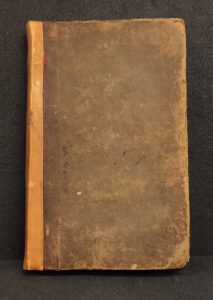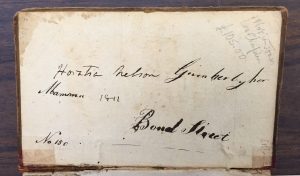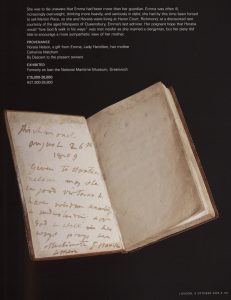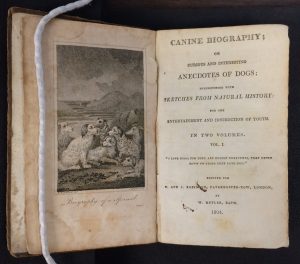By Ellen Cloyed, W&M Libraries Rare Books Cataloger
If you like old books, look carefully at any inscription you find within – you may have a valuable treasure as well as an unexpected mystery to solve.
 A copy of Canine Biography given to Horatia Nelson.
A copy of Canine Biography given to Horatia Nelson.The SCRC holds the second largest collection of books about dogs in the United States. The collection was created by an initial donation from Howard Chapin, and expanded by Murray and Shirley Horowitz in the 1980s. Our mystery lies in an unremarkable looking volume sold to the latter couple by a British rare book dealer, described as follows: “Canine Biography etc. Printed in Bath, 1804 original boards, rebacked spine, 2 vols in 1, Inked inscription inside cover dated 1811. Not in Jones or Chapin. UNRECORDED. £105.00.” This volume later came to Swem Library as part of the donation of books on dogs from Dr. and Mrs. Horowitz. Eventually it found its way into the hands of a cataloger who would take a closer look at the “inked inscription” inside.
 Inscription inside Canine Biography, part of the SCRC's Chapin-Horowitz collection of books about dogs.
Inscription inside Canine Biography, part of the SCRC's Chapin-Horowitz collection of books about dogs.
In October 2005, Sotheby’s held an auction of Vice Admiral Horatio Lord Nelson memorabilia to coincide with the two hundredth anniversary of the Battle of Trafalgar. Nelson was one of Britain’s greatest heroes, a small man but larger than life, with a married mistress of dazzling charm; their affair and illegitimate daughter shocked and mesmerized all of Europe. The sale of his and Lady Emma Hamilton’s mementoes raked in millions of pounds, and Lot 51 alone commanded a hammer price of £18,000. What was it? Another unremarkable looking book called Moral Maxims, containing 548 suggestions on living a righteous life. It had been inscribed in 1809 by the giver to her then eight-year-old daughter, Horatia Nelson, in Emma Hamilton’s characteristic downhill scrawl. The sentiment expresses hope that Horatia would be “good, virtuous & have wisdom….” Oddly, it was signed, “Her affectionate E Hamilton.”
 Image of the inscription in Moral Maxims from the Sotheby's catalogue of Trafalgar: Nelson and the Napoleonic Wars (October 5, 2005).
Image of the inscription in Moral Maxims from the Sotheby's catalogue of Trafalgar: Nelson and the Napoleonic Wars (October 5, 2005).
Was Emma thinking of maxim no. 15: “Whatsoever brought upon thee, take cheerfully; and be patient when thou art changed to a low estate?” It’s tempting to see irony in this; by the time of Emma’s gift to Horatia her fortunes had certainly changed. Emma’s husband, Sir William Hamilton, had died in 1803, and in 1805 Nelson had fallen to a sharpshooter while directing manoeuvers during the Battle of Trafalgar. It took him hours to die, in which time he left directions intended to make Emma and Horatia financially secure, as Lady Hamilton was known to be improvident with money when it was plentiful. But once he was dead, so was his influence. What little Emma had was soon gone as she was constantly importuned by relatives who later shunned her. Poor health ruined her looks and the government denied her a promised pension. Nelson’s fascinating mistress had become a national embarrassment.
Two years later, she gave another small, brown book to this unacknowledged daughter; this inscription much briefer: “Horatia Nelson, 1811." This previously unidentified Emma Hamilton holograph was Canine Biography, a book full of animal anecdotes the now ten-year-old child could enjoy, and the volume that would eventually become part of the SCRC’s rare books collection. But here’s the mystery: whose hand added additional words, “Given her by her Mamma, No 150 Bond Street”? Horatia Nelson died thinking she might be the illegitimate daughter of the Queen of Naples and Lord Nelson, a silly idea put into her head by Emma (and one that cost Emma her friendship with that queen). To her, Emma was merely a guardian, and one she didn’t get along with particularly well. By the time they were living at Bond Street, creditors were hounding them, and most of the household staff had been dismissed. The most logical candidate, Mary Lyon, Emma’s mother (who lived with them and functioned as a servant) had died in 1810. Who, then, would take quill in hand to contradict an accepted fiction, and why?
 Title Page of Canine Biography.
Title Page of Canine Biography.
How did Canine Biography part ways with Horatia? Was it ever enjoyed by any of her own children after she married a vicar and lived quietly into old age as Mrs. Philip Ward? It’s unlikely that we’ll ever know.
For more on Emma Hamilton and a photograph of Horatia's copy of Moral Maxims, see England's Mistress: The Infamous Life of Emma Hamilton by Kate Williams (Ballentine, 2006).